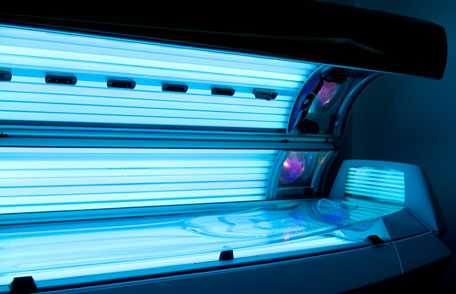Student Indoor Tanning
 Learn about two Prevention Research Centers’ discovery of indoor tanning use among college students and steps they took to raise awareness.
Learn about two Prevention Research Centers’ discovery of indoor tanning use among college students and steps they took to raise awareness.
Indoor tanning exposes users to intense ultraviolet (UV) radiation, which damages the skin and can lead to skin cancer, including melanoma—the deadliest type of skin cancer. According to some research, tanning salons tend to exist in areas with a greater number of girls and women aged 15-29 years and are particularly concentrated near colleges. Those who begin indoor tanning during adolescence or early adulthood have a higher risk of getting melanoma. Individuals who tan more frequently also have higher risks of melanoma. Melanoma results in nearly 9,000 deaths every year.

The use of university sponsored debit cards to purchase indoor tanning may have a negative effect on thousands of college students. Learn how you can raise awareness.
PRC Indoor Tanning Research
Despite scientific evidence that indoor tanning increases risk for skin cancer, this practice is still common among young adults. Researchers from the University of Colorado Denver's Prevention Research Center (PRC) for family and child health, and the University of Massachusetts Medical School—Worcester PRC studied environmental factors that encourage frequent indoor tanning among young adults. The two related studies revealed that students often could:
- Pay for indoor tanning sessions at local tanning salons with their school-sponsored ID/debit card.
- Participate in indoor tanning at tanning facilities on their college campuses.
- Participate in unlimited indoor tanning at facilities in off campus housing as part of their rental agreement.
Denver researchers discovered that among the largest residential 4-year universities in each state, out of the top 96 universities identified from Collegboard.org, 94 Universities sponsored debit cards. Among the Universities with sponsored debit cards, 18 identified indoor tanning salons as eligible merchants. These 18 universities had a combined student population of more than 400,000 undergraduates that could have been affected by their universities' policies.
Researchers from the University of Massachusetts found that out of the top 125 universities listed in the US News and World Report, 15 allowed indoor tanning on campus. This number represented a combined undergraduate student body of more than 520,000. Fifty-three universities offered indoor tanning in off-campus housing and 19 referred students to these housing facilities through their website.
University Guidelines Improved
To raise awareness about university agreements with tanning businesses, Denver researchers published a letter to the editor in the Journal of the American Academy of Dermatology. The research letter urged universities to end their organizations' student ID/debit card programs with indoor tanning salons. As a result of the research letter, other organizations also raised concerns. For example, the Melanoma Foundation worked with partners to reach out to the 18 universities about taking steps to end their practices.
After the letter was published, Denver researchers wrote to encourage senior leaders in universities' dermatology and oncology departments, cancer centers, and student health services, and wrote to the university president, vice president, and general counsel directly.
As of February 2015, five universities (Rutgers University, University of Illinois, Western Kentucky University, Southern New Hampshire University, and Virginia Polytechnic Institute and State University) no longer displayed indoor tanning salons as affiliated merchants on their college ID/debit card websites. Additionally, the University of Pittsburgh no longer allows merchants to accept debit cards for indoor tanning and the University of Denver has plans to end its relationship with indoor tanning merchants.

Some people are at a higher risk of skin cancer than others, but anyone can get it. Indoor tanning and tanning outside are both dangerous.
Next Steps: Raising Awareness Together
Understanding the risk of indoor tanning exposure is crucial to protecting ourselves and our loved ones. Everyone can play a part to help reduce the use of tanning devices—especially on or near college campuses—and the rising number of skin cancer and melanoma cases.
Know the facts about indoor tanning, including its risks [579 KB], and share them with your friends and families.
Faculty, parents, and students:
- Find out what your university's policies and practices are related to indoor tanning.
- Send letters to your university's leadership about changing their guidelines if they engage in practices that encourage student indoor tanning.
- Work with your student associations to come up with ways to influence university administration to stop tanning agreements.
Colleges:
- Ensure organizational policies do not unintentionally promote unhealthy behaviors like indoor tanning.
- Refer your students to off-campus housing that embraces your campus' health guidelines.
Clinicians:
- Advise adolescent and young adult patients about the harms of intentional tanning, especially indoor tanning, and the importance of sun-protective behaviors.
To learn more ways to raise awareness about indoor tanning, its potential health risks, and prevention methods, see The Surgeon General's Call to Action to Prevent Skin Cancer. [9.25 MB]
The Prevention Research Centers Program is made up of 26 centers associated with schools of public health or with a medical school that has a preventive medicine residency program. PRCs work with at-risk communities to promote health and prevent chronic diseases such as cancer, heart disease, and diabetes.
References
- Boyers L, Karimkhani C, Crane LA, et al. Buying indoor tanning with university debit cards. Journal of the American Academy of Dermatology. 2014;71(1):199-201.
- Centers for Disease Control and Prevention. Skin Cancer website. Accessed March 27, 2015.
- Pagoto SL, Lemon SC, Oleski JL, et al. Availability of tanning beds on US college campuses. Journal of the American Academy of Dermatology. 2015;151(1):59-63.
- Patel MR, Mayer JA, Slymen DJ, et al. Correlates of tanning facility prevalence within San Diego County, California census tracts. Journal of Community Health. 2007;32(6):391-400.
- US Department of Health and Human Services. The Surgeon General's Call to Action to Prevent Skin Cancer [9.25 MB. Washington, DC: US Dept. of Health and Human Services, Office of the Surgeon General; 2014. Accessed March 31, 2015.
- US Department of Health and Human Services. The Surgeon General's Call to Action to Prevent Skin Cancer Executive Summary website. Accessed March 27, 2015.
- Page last reviewed: June 15, 2015
- Page last updated: June 15, 2015
- Content source:
- National Center for Chronic Disease Prevention and Health Promotion, Division of Population Health
- Page maintained by: Office of the Associate Director for Communication, Digital Media Branch, Division of Public Affairs




 ShareCompartir
ShareCompartir
